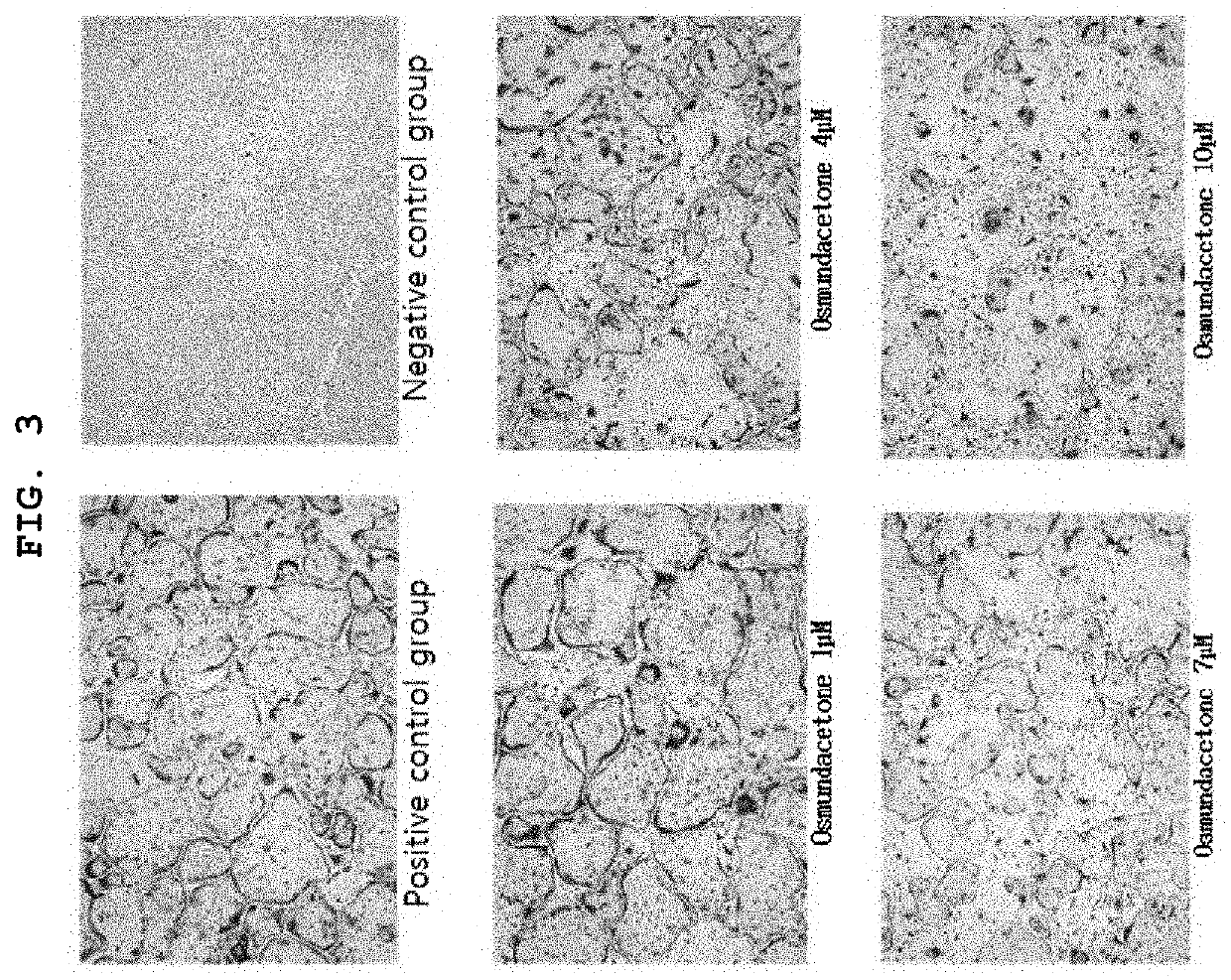Composition comprising osmundacetone or pharmaceutically acceptable salt thereof for preventing or treating bone disease
a technology of osmundacetone and osmundacetone, which is applied in the direction of drug compositions, food ingredients, plant/algae/fungi/lichens ingredients, etc., can solve the problems of high price insufficient suppression of the resorption of bone parenchyma of osteoclasts, and side effects of existing osteoporosis medicines, etc., to achieve strong inhibitory effect on the proliferation and differentiation
- Summary
- Abstract
- Description
- Claims
- Application Information
AI Technical Summary
Benefits of technology
Problems solved by technology
Method used
Image
Examples
application example 1
[0210]Osteoporosis
[0211]Bone is maintained through a balanced bone remodeling cycle between osteoclasts that metabolically resorb bones and osteoblasts that form bones. However, when osteoclasts are extremely activated due to the destruction of the balance between osteoclasts and osteoblasts, the balance between bone resorption and formation is destroyed, and thus the amount of bone uptake is greater than the amount of bone formation, causing osteoporosis (Kim J H and Kim N, 2016; Shiozawa Y et al., 2011).
[0212]Therefore, osmundacetone of the present invention simultaneously shows an effect of inhibiting the proliferation and differentiation of osteoclasts and an effect of activating osteoblasts, and thus can exhibit a preventive or therapeutic effect on osteoporosis.
application example 2
[0213]Rheumatoid Arthritis
[0214]Rheumatoid arthritis is an autoimmune disease, and autoimmune antibodies promote osteoclast differentiation. The resultant excessive bone resorption worsens rheumatoid arthritis (Takayanagi H, 2007). The mechanism thereof is as follows. NFAT transcription factors (NFATc1 / c2 / c3 / c4), which are key transcription factors related to osteoclast differentiation, are basically activated by calcium / calmodulin signaling (Takayanagi H et al., 2002). For complete activation, tyrosine-based activation motif (ITAM)-bearing molecules, such as the immunoregulatory protein DNAX-activating protein 12 (DAP12) and the immune antibody Fc receptor common γ chain (FcRγ), stimulates calcium signaling in immune cells (Pitcher L A and van Oers N S, 2003). Also, DAP12 and FcRγ activate NFATc1 through calcium signaling in osteoclasts. Therefore, immunoglobulin-like receptors involved in DAP12 and FcRγ play a key role in the differentiation of osteoclasts (Koga T et al., 2004; Mo...
application example 3
[0216]Paget's Disease (Osteitis deformans)
[0217]Paget's disease (Osteitis deformans) is also caused by abnormal bone resorption of osteoclasts (Singer F R, 2016). Therefore, abnormal osteogenesis of osteoblasts progresses, and this process is repeated, resulting in bone malformation, causing pains, headache, hearing loss, or the like, resulting therefrom. Paget's disease is frequently caused in arms, legs, pelvis, spine, and skull. The newly formed bone is weak, and thus the frequency of fracture is high. Hypercalcemia, heart attack, and hemiparesis may be caused (Ralstone S H, 2016). The cause of the disease is unknown, but genetic susceptibility and childhood virus infection are suspected to be the cause. The medication treatment is helpful in inhibiting the progression of the disease. Fosamax, an osteoclast differentiation inhibitor, and calcitonin, which regulates bone metabolism, are currently the most commonly used medicines. However, Fosamax is restricted in long-term use in ...
PUM
 Login to View More
Login to View More Abstract
Description
Claims
Application Information
 Login to View More
Login to View More - R&D
- Intellectual Property
- Life Sciences
- Materials
- Tech Scout
- Unparalleled Data Quality
- Higher Quality Content
- 60% Fewer Hallucinations
Browse by: Latest US Patents, China's latest patents, Technical Efficacy Thesaurus, Application Domain, Technology Topic, Popular Technical Reports.
© 2025 PatSnap. All rights reserved.Legal|Privacy policy|Modern Slavery Act Transparency Statement|Sitemap|About US| Contact US: help@patsnap.com



